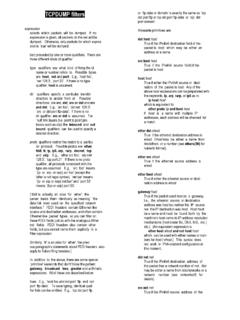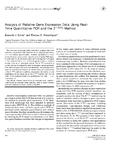Transcription of Pluronic block copolymers: novel functional molecules for
1 Advanced Drug Delivery Reviews 54 (2002) 223 233. / locate / drugdeliv Pluronic block copolymers: novel functional molecules for gene therapy a, b a b Alexander V. Kabanov *, Pierre Lemieux , Sergey Vinogradov , Valery Alakhov a Department of Pharmaceutical Sciences, University of Nebraska Medical Center, 986025 Nebraska Medical Center, Omaha, NE 68198, USA. b Supratek Pharma Inc., 531 Blvd. des Prairies, Build. 18, Laval, Quebec H7 B 1 B7, Canada Abstract Pluronic block copolymers are recognized pharmaceutical excipients listed in the US and British Pharmacopoeia. They have been used extensively in a variety of pharmaceutical formulations including delivery of low molecular mass drugs and polypeptides. This review describes novel applications of Pluronic block copolymers in gene therapy. In particular, these molecules can modify the biological response during gene therapy in the skeletal muscle, resulting in an enhancement of the transgene expression as well as an enhancement of the therapeutic effect of the transgene.
2 Furthermore, Pluronic block copolymers are versatile molecules that can be used as structural elements of the polycation-based gene delivery systems (polyplexes). Based on these studies, the use of block copolymers in gene delivery is a promising area of research, in which new and important developments are expected. 2002 Elsevier Science All rights reserved. Keywords: Gene delivery; Gene therapy; DNA; Polycation; block copolymer ; Poly(ethylene glycol). Contents 1. Introduction .. 223. 2. Structure and synthesis of Pluronic block copolymers .. 224. 3. Self-assembly of Pluronic block copolymers .. 224. 4. Pluronic block copolymers as biological adjuvants .. 225. 5. Enhancement of transgene expression in skeletal muscle by Pluronic .. 225. 6. Pluronic -polycation conjugates for gene delivery .. 227. 7. Pluronic -polycation conjugates for delivery of oligonucleotides .. 229. 8. Conclusion .. 230. Acknowledgements .. 230. References .. 231. 1. Introduction *Corresponding author.
3 Tel.: 11-402-559-9364; fax: 11-402- The field of non-viral gene therapy has recently 559-9543. gained increased interest [1]. It is widely believed E-mail address: ( Kabanov). that non-viral gene therapy can overcome some 0169-409X / 02 / $ see front matter 2002 Elsevier Science All rights reserved. PII: S0169-409X( 02 )00018-2. 224 Kabanov et al. / Advanced Drug Delivery Reviews 54 (2002) 223 233. problems inherent to current viral-based therapies, results in an amphiphilic copolymer , in which the including immune and toxic reactions as well as the number of hydrophilic EO (x) and hydrophobic PO. potential for viral recombination [2]. One major ( y) units can be altered to vary the size, hydro- approach in non-viral gene therapy is based on philicity and lipophilicity. The structure formula of polyplexes', complexes formed by mixing DNA Pluronic block copolymers is presented in Fig. 1. with synthetic polycations [3,4]. The polyplexes Copolymers with various x and y values are char- form spontaneously as a result of electrostatic inter- acterized by distinct hydrophilic lipophilic balance actions between the positively charged groups of the (HLB).
4 The nomenclature of Pluronic block co- polycation and the negatively charged phosphate polymers is explained in Appendix A. groups of the DNA. This results in DNA condensa- Pluronic block copolymers are synthesized by tion, protection from the nuclease digestion, and sequential polymerization of PO and EO monomers more efficient delivery within a cell. A variety of in the presence of an alkaline catalyst, such as polycation molecules have been proposed for poly- sodium or potassium hydroxide [8]. The initial stage plex formation [3,4]. These molecules differ in the of the synthesis includes growth of the PO block chemical composition and the number of the repeat- followed by the growth of EO chains at both ends of ing units, as well as in the architecture of the the PO block . Anionic polymerization usually polymer backbone, which may be linear, randomly produces polymers with a low polydispersity index branched, dendrimeric, block - or graft copolymer .
5 (Mn /Mw ). However, the commercially available An alternative approach for gene delivery evaluates Pluronic preparations may contain admixtures of nonionic polymers, such as poly(vinyl pyrrolidone), the PO homopolymer as well as di- and triblock which enhance gene expression of naked DNA in copolymers, exhibiting lower degrees of polymeri- select tissues, such as skeletal muscle [5,6]. In zation than expected. Chromatographic fractionation contrast to polyplexes such nonionic polymers en- can be employed in procedures for the manufacture hance gene expression through mechanisms, which of highly purified block copolymers [9]. This reduces most likely do not involve DNA condensation and the presence of admixtures, particularly, of the PO. facilitated transport within cells [7]. The current homopolymer and of the block copolymers con- review describes a novel nonionic polymer class, taining less of the EO block than expected. Pluronic block copolymers, which appear to be very valuable for gene delivery in skeletal muscle.
6 Furthermore, Pluronic block copolymers have proven to be useful elements in polyplexes on the 3. Self-assembly of Pluronic block copolymers base of the polycation and DNA complexes that have a potential in a variety of gene therapy applications. A defining property of Pluronic is the ability of Both types of applications of the Pluronic block copolymers for gene delivery are considered along with some major aspects of self-assembly and bio- logical properties of these block copolymers, which are essential for the development of such gene delivery systems. 2. Structure and synthesis of Pluronic block copolymers Pluronic block copolymers (also termed Polox- amer' or Synperonic') consist of ethylene oxide Fig. 1. Pluronic block copolymers available from BASF (Wyan- (EO) and propylene oxide (PO) blocks arranged in a dotte, MI), contain two hydrophilic EO blocks and a hydrophobic triblock structure: EO x PO y EO x . This arrangement PO block . Kabanov et al.
7 / Advanced Drug Delivery Reviews 54 (2002) 223 233 225. individual block copolymer molecules , termed un- 4. Pluronic block copolymers as biological imers', to self-assemble into micelles in aqueous adjuvants solutions. These unimers' form a molecular disper- sion in water at block copolymer concentrations In addition to the use of Pluronic block co- below the critical micelle concentration (CMC). At polymers as structural components of micellar drug concentrations of the block copolymer above the formulations, Pluronic -based systems exhibit a CMC, the unimer molecules aggregate, forming variety of useful biological properties. For example, micelles through a process called micellization'. The water-in-oil, oil-in-water and water-in-oil-in-water driving force for the micellization is the hydrophobic emulsions formulated with select Pluronic block interactions of the PO blocks. The PO blocks self- copolymers have been used extensively as immuno- assemble into the inner core of the micelles covered adjuvants [20 31].
8 These studies suggested signifi- by the hydrophilic corona from EO blocks. Pluronic cant enhancement of both cell-mediated and humoral micelles are commonly pictured as spheres com- immune response induced by addition of the block posed of a PO core and an EO corona. This portrayal copolymer formulations with respect to a very broad is correct for most block copolymers, which have an spectrum of antigens. Selected block copolymers, EO content above 30%, especially in relatively dilute such as Pluronic F127 have been found to sig- solutions at body temperature. However, additional nificantly enhance the rate of wound and burn micelle morphologies, including lamella and rods healing, and therefore have been included in cream (cylinders), can also form in Pluronic systems [10]. formulations and skin substitutes for the treatment of When spherical micelles are formed, depending on burns and for other tissue engineering applications the Pluronic type the micelles commonly have an [32 39].
9 Several Pluronic -based formulations were average hydrodynamic diameter ranging from about shown to effectively prevent postoperative adhesions 20 to about 80 nm [10]. The number of block or at least to reduce adhesion area after surgery copolymer unimers forming one micelle is referred [40,41]. Furthermore, Pluronic block copolymers to as the aggregation number'. Usually this number can enhance sealing of cell membranes permeabil- ranges from several to over a hundred. ized by ionizing radiation and electroporation thus The process of transfer of water-insoluble com- preventing cellular necrosis, which can be helpful for pounds into the PO core of the micellar solution is improving drug and gene delivery in skeletal muscle referred to as solubilization'. Pluronic micelles [42 44]. Recent studies have demonstrated that containing solubilized low molecular mass drugs and select Pluronic block copolymers can interact with polypeptides are being actively investigated as po- multidrug resistant (MDR) cancer cells resulting in tential drug delivery systems [11 19].
10 The core-shell chemosensitization of these cells [45 49]. These architecture of polymeric micelles is essential for interactions involve alteration of the structure of cell their utility for these applications. The core formed membranes by block copolymer molecules as well as by the PO chains is a water-incompatible compart- energy depletion in MDR cells leading to the inhibi- ment that is segregated from the aqueous exterior by tion of various energy-dependent drug resistance the hydrophilic chains of the EO corona, thereby mechanisms. Therefore, formulation of many anti- forming, within the core, a cargo hold' for the cancer drugs with such block copolymers results in incorporation of various therapeutic reagents. As a enhancement of the chemotherapy of cancer [45,50]. result, polymeric micelles can be used as efficient These examples show that the block copolymers carriers for compounds, which alone exhibit poor exhibit valuable biological activities, which can be of solubility, undesired pharmacokinetics and low considerable importance for various therapeutic ap- stability in a physiological environment.








